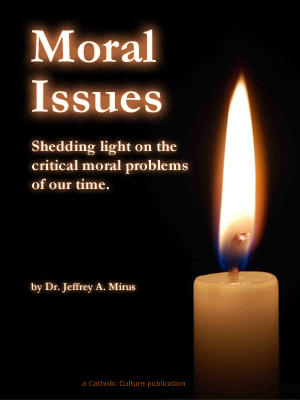How Father Brown Led Sir Alec Guinness to the Church
Sir Alec Guinness is considered one of the finest actors of the twentieth century, known for his ability to portray a wide range of characters. His portrayal of Hamlet on the London stage was widely acclaimed, and he won international success in his films. Who can forget his masterly depiction of Fagan in Oliver Twist or the wry humor in the comedies Kind Hearts and Coronets (in which he played eight roles), The Man in the White Suit, The Lavender Hill Mob, and The Captain's Paradise?
In 1957, Guinness won an Academy Award for best actor for his performance in The Bridge over the River Kwai. Later films included Star Wars, Little Dorrit, and the television series Tinker, Tailor, Soldier, Spy, and Smiley's People. In 1959 he was knighted by Queen Elizabeth. Yet in his autobiography, Blessings in Disguise, Guinness highlights his conversion to the Catholic Church almost more than the success of his acting career.
His was an unusual conversion.
Alec Guinness was born in London in 1914 to Agnes Cuffe, an unmarried woman who cared for him in a haphazard manner. She refused to divulge his father's identity, and he never discovered why the name Guinness appeared on his birth certificate. By the time he was six, the child often was left alone for hours at a time. His mother entered a brief marriage to a brutal man who was hated and feared by young Alec. The boy's only release from the misery of poverty and neglect came when he was sent away to school. As a teenager, he discovered the enchantment of the theater.
At the age of sixteen, Guinness was confirmed in the Anglican faith, but he secretly declared himself an atheist. "Certain incidents or sayings in the New Testament," he wrote, "would pluck me back, from time to time, to something approaching belief, and I retained a constant interest in religious matters while being ignorant of any theology, but for the most part gave in to adolescent cynicism."
This "constant interest in religious matters" led the young Guinness to attend Presbyterian services for a time, but the attraction did not last. He wrote in his autobiography that it had never even crossed his mind to step inside a Catholic church. He said his "tolerance for Catholics, unless one personally knew them, was limited to the sympathetic, although condescending" view.
Guinness left school at eighteen and went to work as a copywriter for an advertising agency. He no longer thought much about religion, believing it just "so much rubbish, a wicked scheme of the Establishment to keep the working man in his place." He flirted with Communism by distributing Marxist/Leninist literature. He visited Quaker meetings, investigated Buddhism, and had an interest in tarot cards.
Guinness's career as a copywriter was a failure, so he turned to the stage, realizing an attraction he had since childhood. Success came soon.
He was playing Hamlet at the Old Vic when an Anglican priest visited him in his dressing room. The priest complained that Guinness was blessing himself incorrectly in the play. This encounter turned out to be a step back toward Christianity.
On a terrible night during World War II, when London was under a Luftwaffe attack, Guinness sought shelter at Rev. Cyril Tomkinson's vicarage. He was concerned about his wife and their young son, who were in a rented cottage in Stratford-upon-Avon. Over a glass of claret, the Anglican cleric gave Guinness a copy of St. Francis de Sales's Introduction to the Devout Life and advised him always to genuflect before the altar. Guinness had no idea what was meant by the "Real Presence," but with bombs exploding around them, it did not seem the appropriate time for discussion.
Guinness returned to the Anglican faith and often bicycled in the dark of winter mornings to receive communion in a country church. His friendship with Tomkinson had reduced his anti-clericalism but not his anti-Romanism. It took Father Brown to begin that process.
Father Brown is the drab and delightful Catholic priest invented by G. K. Chesterton. One of Guinness's most memorable characterizations was of this humble, crime-solving cleric. The film was being shot in a remote French village. One evening Guinness, still in costume, was on his way back to his lodgings. A little boy, mistaking him for the real thing, grabbed his hand and trustingly accompanied the "priest."
That incident affected Guinness. "Continuing my walk," he said, "I reflected that a Church that could inspire such confidence in a child, making priests, even when unknown, so easily approachable, could not be as scheming or as creepy as so often made out. I began to shake off my long-taught, long-absorbed prejudices."
Shortly thereafter, Guinness's son Matthew, age eleven, was stricken with polio and paralyzed from the waist down. The future for the boy was doubtful, and at the end of each day's work on the film, Guinness began dropping in at a little Catholic church on his route home. He decided to strike a bargain with God: If God would let Matthew recover, Guinness would not stand in the way if the boy wished to become Catholic.
Happily Matthew recovered completely, and Guinness and his wife enrolled him in a Jesuit academy. At the age of fifteen, Matthew announced that he wished to become Catholic. Guinness kept his end of the bargain with God: He readily agreed to the conversion.
But God wanted much more. Guinness began to study Catholicism. He had long talks with a Catholic priest. He made a retreat at a Trappist abbey. He even attended Mass with Grace Kelly while he was working on a film in Los Angeles. The doctrines of indulgences and infallibility slowed him for a time, but his description of finally entering the Church said it all: "There had been no emotional upheaval, no great insight, certainly no proper grasp of theological issues; just a sense of history and the fittingness of things."
Guinness was received into the Catholic Church by the bishop of Portsmouth, and while he was in Sri Lanka making The Bridge over the River Kwai, his wife surprised him by also converting. As is often the case with new converts, he felt periods of deep peace punctuated by physical delight. He recounts once running like a madman to visit the Blessed Sacrament in a little nondescript church. Reflecting on that episode, he wrote, "If religion meant anything at all it meant that the whole man worshiped, mind and body alike . . . There was some reassurance when I discovered that the good, brilliant, acutely sane Ronald Knox had found himself running, on several occasions, to visit the Blessed Sacrament."
Sir Alec Guinness died in 2000 at the age of eighty-six, grateful to Chesterton's Father Brown, who led him by the hand into the Church, and to a young boy's recovery, which sealed a bargain with God.
Rita Reichardt is a mother of five. She is a former high school teacher, has been a parish catechism teacher, and currently leads a Catholic Great Books program. She writes from La Grange, Illinois.
© Catholic Answers, Inc.
This item 6679 digitally provided courtesy of CatholicCulture.org







